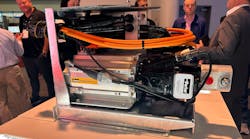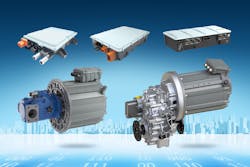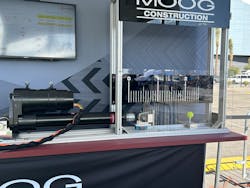Today it's hard to go anywhere without hearing or talking about electrification, especially in regard to vehicles of various types. At the International Fluid Power Exposition (IFPE) and co-located CONEXPO/CON-AGG in March 2023 it was a key trend throughout the show for component suppliers and OEMs alike.
Visit our IFPE channel for news, video interviews and more related to the year's largest event dedicated to the fluid power, motion control and power transmission industries.
But what impacts will electrification have on hydraulics and pneumatics, and other motion control technologies? The industry consensus seems to be that the effects will be varied, and it is important to monitor what is happening in this space due to its rapid rate of growth.
During an interview with Power & Motion at IFPE 2023, Mourad Chergui, Senior Product Manager at Delta-Q Technologies — a developer of on-board battery chargers — said the company estimates a larger share, close to 50%, of heavy-duty mobile equipment will be electrified by 2035.
New Requirements and Technology
With the growth of electrification over the last several years have come changes to several aspects of machine and vehicle designs, including to fluid power systems.
Key among these is the need for components to be more efficient. As Russ Schneidewind, OEM Sales Manager at HydraForce, noted in an interview with Power & Motion, mobile hydraulics have been spoiled over the years because with diesel engines the efficiency of hydraulics was not as much of a concern.
However, electrification requires an improvement in hydraulics' energy efficiency because batteries and other power sources used in place of diesel engines are not as power dense. Finding ways to reduce energy consumption from fluid power systems ensures electric power sources have enough energy to provide the typical operating hours between charges machine operators expect from a diesel equivalent machine.
To achieve the efficiency gains necessary for electric-powered machines, Danfoss Power Solutions found it beneficial to rethink the system architecture for an electric wheel loader concept it developed with its Editron division which is focused on electric powertrain technologies. Doing so allowed the company to separate the propel and hydraulic work functions of the wheel loader, leading to reduced power consumption and efficiency gains.
Like many other companies in the fluid power industry, Danfoss sees the value in diversifying its portfolio to include components and systems for electrified machines. Not only does it enable the company to meet changing customer requirements but also helps to ensure optimized performance as it can bring its expertise in hydraulics to assure all components will work well with one another.
Peter Dschida, Senior Vice President - Sales at Bosch Rexroth, said during the company's press conference at IFPE that the company sees a mixture of electric and hydraulic machines in the market, hence its continued development of hydraulic components as well as those for electric-powered equipment. The company's eLION portfolio of high-voltage components was developed specifically for use in mobile equipment such as construction and agricultural machinery. eLION includes electronic and hydraulic components to fit a range of hybrid- and full-electric equipment requirements.
Electrification is also bringing the opportunity to incorporate technologies in place of fluid power components. For instance, Moog Inc. has worked with OEMs Bobcat and Komatsu to develop full-electric machines which have no hydraulics. Instead of the hydraulics system, Moog's intelligent machine electrification system is utilized which consists of electric cylinders, an electric traction motor, battery and battery management system, as well as additional electronics. With this system, a higher level of efficiency and controllability can be achieved to optimize performance and enable implementation of future technologies such as automation.
READ MORE about Moog's work on the Bobcat and Komatsu electric machines:
Moog and Komatsu Develop All-Electric Wheel Loader
Completely replacing fluid power systems, at least for the time being, will depend on the application. Compact machines like the Bobcat and Komatsu examples above are instances where it could make sense due to their lower power requirements and the advancement of technologies such as electric actuators to meet application needs. However, larger machines will likely still need to use hydraulics, at least in the foreseeable future.
What Impacts are You Seeing?
So where is all of this electrification stuff going, and what additional impacts could there be on hydraulics and pneumatics? Only time will tell as there is clearly a lot of work taking place in this area, evident from the amount of news we receive and discussions we have on the subject as well as how present it was at CONEXPO & IFPE 2023.
To get a better pulse on how it is impacting the industry and our readers' jobs, Power & Motion is looking for insights from our readers on electrification in fluid power. Through the end of April we'll be conducting a survey to gauge current impacts of electrification and where the industry sees this trend heading in the future.
You can find the survey here to provide your input.
Or feel free to contact me directlyat [email protected]to let me know your thoughts on this growing industry trend. You can also reach out to us on social media:Twitter: @TechnlgyEditor or @PowerMotionTech
LinkedIn: @PowerMotionTech





